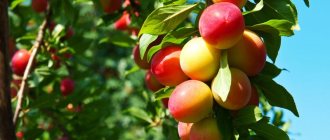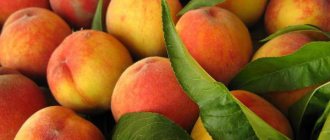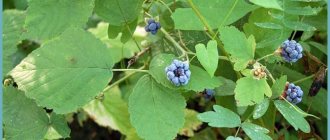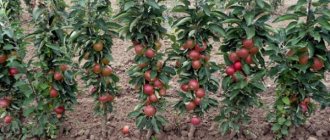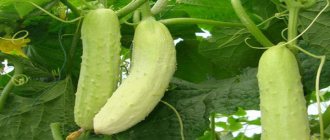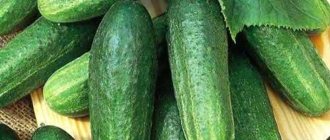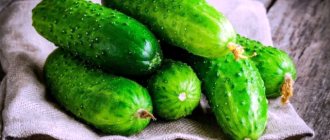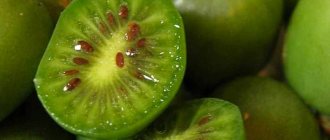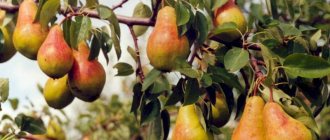Choosing the best variety for the Urals
It is recommended that you read in advance the description of the varieties of cucumbers that can be grown in the Southern Urals. This will help you choose the best vegetable variety for that region.
According to ripening time
It is known that all vegetables differ in terms of harvest ripening. Popular early-ripening cucumbers that can be grown in the Urals include:
- Amur. An early variety, the fruits of which ripen 35-45 days after planting. The advantages of Amur include its resistance to temperature changes and dampness.
- Podmoskovny. This vegetable is suitable for growing outside as it is frost-resistant. It is undemanding in terms of lighting and therefore can be planted in shaded areas of the garden.
Among cucumbers with medium ripening periods there are:
- Voyage. Despite its resistance to low temperatures, gardeners advise planting Voyage in a greenhouse. In greenhouse conditions, the harvest will ripen in 50-55 days.
- Arina. A frost-resistant vegetable that is often grown in the Urals. The peculiarities of the variety include the fact that its fruits are best consumed fresh. They are not suitable for preparing winter preparations.
There are also late-ripening cucumbers, which are popular among Ural vegetable growers:
- Hercules. It is considered the latest ripening vegetable, the fruits of which ripen within 70 days. It is recommended to grow Hercules in greenhouse conditions to get more yield.
- Claudia. A variety with late-ripening fruits that ripen in two and a half months. The advantages of Claudia include the taste of the fruit, which does not have a bitter aftertaste.
Greenhouse
There are several varieties that grow best in greenhouse conditions at a temperature of 15-20 degrees. These include:
- Emelya. An early-ripening hybrid variety that ripens in 25-35 days. It does not tolerate low temperatures well and is therefore grown only in greenhouses. With proper care of seedlings, the weight of each fruit will be 100-120 grams.
- Dynamite. Among the large-fruited Ural cucumbers, Dynamite is distinguished, the fruits of which grow up to 150 grams. When grown in open ground, the yield of the vegetable deteriorates, and therefore experienced vegetable growers recommend planting it in greenhouses.
- Friendly family. A mid-early plant that is suitable for growing indoors. The first ripe fruits appear on the bushes 40-50 days after sowing the seeds. The harvested crop is used to create fresh salads and preserves.
- Matilda. Hybrid cucumber with early harvest ripening. Matilda's advantages include self-pollination and taste. If you create optimal conditions in a greenhouse, you can get more than 10 kilograms of harvest from a bush.
For open areas
Not all gardeners have the opportunity to grow vegetables in greenhouses, and therefore they have to grow them outside. The following varieties are suitable for this:
- Nezhinsky. This vegetable is planted only in the garden, as bees are needed for pollination. Nezhinsky is classified as a cucumber with an average ripening period. The fruits are used for pickling, pickling and preparing salads.
- Delicious. It copes with nighttime temperature changes and therefore can be planted outside. In order for the plant to better tolerate frost, it is planted in loose and fertile soils with a large amount of nutrients.
- Pickling. A mid-season vegetable that ripens within one and a half months. Its distinctive feature is considered to be large fruits, weighing 145-160 grams. The ripe harvest is used to create preparations for the winter.
See also
When to plant cucumbers in open ground in Siberia, how to grow and the best varieties
Read
The most delicious
Many gardeners want to get a delicious harvest. There are several varieties of cucumbers that have excellent taste:
- Vyaznikovsky. A high-yielding vegetable with tasty fruits weighing 150 grams. The plant is classified as an early-ripening crop; cucumbers ripen two months after the first shoots germinate. The advantages of Vyaznikovsky include its ability to adapt to different climatic conditions.
- Unworn. It was bred by domestic breeders in the middle of the last century for cultivation in unfavorable climatic conditions. 40-55 days after planting, oblong fruits appear on the bushes, which grow up to 12 centimeters in length. They do not turn yellow after collection and have good transportability.
- Elegant. An early ripe cucumber, which is recommended to be planted in open ground. The fruits of the Graceful grow up to 14 centimeters and have an ellipsoidal shape. The cucumbers are dense, crispy and juicy. They are used to create pickles and vegetable salads.
Harvest crops
To get more yield, it is necessary to plant the most productive varieties. These include:
- Pinocchio. This is the most popular productive type of cucumber, which is suitable for growing in the Urals. Pinocchio fruits ripen very quickly, which makes it possible to collect them in the first half of summer. They are added to salads and winter pickles.
- Zozulya. Crops with high yields include Zozulya cucumbers. Ripe fruits grow up to 20-35 centimeters, they weigh about 200-220 grams. 10-15 kilograms of mature cucumbers are harvested from one plant.
- Farmer. Fans of high-yielding vegetables often plant this variety in their gardens. It can be grown in open ground, but to increase productivity it is better to plant the vegetable in a greenhouse. In favorable conditions, more than 15 kilograms of fruit are obtained per square meter.
Varieties with stable immunity
It is no secret that cucumbers are often subject to diseases, which deteriorate their yield. It is recommended to plant crops with strong immunity and disease resistance:
- Masha. An ultra-early hybrid plant that is protected from many diseases. Among the advantages of the vegetable are its high yield, taste and ease of care. The harvest is suitable for both canning and eating raw.
- Princess. The plant is resistant to common pathologies and unfavorable climatic conditions. The Knyazhna fruits are not very large and grow only 6-7 centimeters. However, this does not affect the yield in any way. Cucumbers in the amount of 7-8 kilograms are collected from each bush.
- Martin. A medium-sized plant whose stem grows up to one and a half meters. Good immunity allows you to grow Swallow in open ground. The ripe harvest has a pleasant aroma, crunches and does not have a bitter aftertaste.
Bundle cucumbers for growing in polycarbonate greenhouses
It’s great to collect not just one cucumber at a time, but whole bouquets; you immediately get a good yield. And this is possible if you plant a bunched variety of greens. It produces many ovaries on one plant at once, all of them miniature in size. In addition, this makes it possible to save space on the site, because the plant is compact. It is even grown on balconies.
The advantages also include simultaneous ripening; one bouquet can contain up to 10 greens. They can be preserved perfectly, maintaining their crispy taste.
- Gavroche. A hybrid with miniature gherkins that have a very attractive appearance. Used fresh, they grow no more than 12-14 cm long. The skin is loose, there are tubercles. In terms of ripening time, they are classified as mid-early.
- Thumb Boy. One of the unpretentious species that is in great demand. After all, productivity in most cases comes first among the various types. It is only 3-4 cm in diameter and about 8 cm tall. There are small spines, whitish in color.
- Garland. Relatively young, early ripening type. It has powerful, medium-branched stems, with green, heart-shaped leaves. The number of flowers in the ovary is 3-5 pieces, of which 10 - 12 cm of greens are obtained. The appearance is very beautiful, without bumps, covered with light thorns. The advantages include its unpretentiousness to lighting; it grows well even in shade.
- Emerald earrings. A vigorous, hybrid species that has medium branching. After 40-45 days, the first harvest appears; the color of the fruits is dark green, elongated, oval in shape, the average size is about 10 cm. The peel has a light fluff and small spines; it will be difficult to collect them without gloves.
To achieve success in growing, you need to put in a lot of effort. Due to the mass production, fertilizing is required, which must be done every week. The soil needs timely watering and loosening. And it is worth noting the love for this type of light, the distribution of illumination is uniform. The temperature is stable.
It is important to pick ripe greens at the right time, otherwise they will take a lot of nutrients and water, and the rest will not have enough for growth. Also, fruits picked in time allow new ones to grow faster in their place.
Also, fruits picked at the right time allow new ones to grow faster in their place.
We germinate the seeds
In order for the first shoots to appear faster, you will have to pre-germinate the seeds. To do this, all the seeds are laid out on a cloth made of natural fiber. Then the fabric surface is watered with warm water. When the fabric begins to dry out, it is re-moistened.
Germination lasts 2-4 days until small sprouts begin to appear on the seeds.
Preparing the soil and beds
Before planting, you need to prepare the soil in which the vegetable will be planted. Sandy and loamy soils, which contain many nutritional components, are considered the most suitable for cucumbers. 2-3 days before planting, organic fertilizers with manure are added to the ground, which contains phosphorus, calcium, potassium and other useful substances. 5-6 kilograms of fertilizer are consumed per square meter.
After applying fertilizers, beds for growing cucumbers are marked on the site.
Late greenhouse cucumbers
Late-ripening species include cucumbers, in which the ripening period for greens is more than 50 days, this time is counted from the moment the first shoots appear from the seeds. They need more time to grow roots and develop bushes. The root system is more developed and provides more nutrition for fruit growth than early ones. They will begin to bear fruit in the second half of the summer season, namely in July.
It is believed that late harvest is better suited for canning.
In order not to be afraid of the changeable weather at the end of the summer months, you can grow this crop in a greenhouse. It will help create favorable conditions for the good growth and development of our green crops. You need to plant the seeds in June; if the weather is good and warm, you can sow them directly into the soil in the garden bed. You can plant, for example:
- Emerald. It has vigorous bushes with medium branching. Medium-sized cucumbers, usually 15-17 cm, cylindrical in shape, weighing 100 - 110 grams each. The skin is smooth, rarely bumpy. They are emerald green in color. Universal in scope.
- Sapphire. Universal hybrid. Resistant to downy mildew. The fruits are cylindrical in shape, with a bumpy surface. Very large 30 - 35 cm and 250 - 350 grams, about 4 cm in diameter. Productivity is high, the last harvests occur in October.
- Alyonushka. It has high taste characteristics, without a bitter aftertaste. They grow to an average length of 10 cm. The collection period is late summer, early autumn. The bushes grow 2-3 meters in length, with medium climbing, the ovary is fascicular, the foliage is rich green.
- Brownie. Hybrid, late fruit ripening. It is famous for its long period of collecting green beauties. They grow neat, 6-8 cm in length. Resistant to a range of different diseases. Mainly used as ingredients for pickling various assorted vegetables and salads.
These varieties are no different in care from early ripening ones. It’s good to have your own vegetables from the garden all the time.
Optimal timing and technology for planting cucumbers
It is recommended to figure out in advance when to plant seeds for seedlings in 2021.
See also
When is the best time to plant cucumbers in open ground in 2021, favorable days according to the lunar calendar
Read
In the greenhouse and in the greenhouse
People who are going to grow vegetables in greenhouses do not know when to plant them. Before you start planting, you need to decide on the timing of planting the seeds and grown seedlings.
Seeds are planted in the first half of May or at the end of April. If the seedlings are grown in a heated greenhouse, the seeds are planted 1-2 months earlier. It is best to transplant young seedlings to a permanent place in early June. However, to obtain an early harvest, the timing is shifted by 1-2 weeks.
Before planting, shallow holes are made in the greenhouse into which the seedlings will be planted. The distance between them should be 30-35 centimeters.
In the open ground
Determining the timing of sowing cucumbers in open ground is more difficult, since you will have to take into account the temperature outside. Cucumbers are considered heat-loving vegetables, and therefore experienced gardeners advise planting them when the soil warms up to 8-10 degrees. You should not plant them in unheated soil, as in such conditions the seeds will germinate slowly.
When planting cucumbers outside, the holes are made deeper to protect the horse system from frost. The depth of the holes should be 10-12 centimeters. After planting, the beds are covered with plastic film to protect them from night frosts.
Cucumbers for the North-West
Cucumbers for the North-West
When talking about the North-West, the first thing that comes to mind is the Leningrad region. This, of course, also includes much more severe regions - the Arkhangelsk and Murmansk regions, the Nenets Autonomous Okrug - well, these are already extremes. But first of all, in addition to the Leningrad region, these are the Kaliningrad, Pskov, Vologda regions, the Republic of Karelia and Komi.
Read on Dacha6.ru:
In general, the region is quite harsh, with fewer warm summer days. This leaves its mark on the choice of cucumber varieties and methods of growing them (mainly greenhouse).
Let's list the varieties most suitable for the North-West:
"Suomi F1" is a parthenocarpic early-ripening variety of universal cucumbers (suitable for salads, canning). The harvest ripens already on the 38th day after the first shoots appear on the surface. Women's flowers. Each node produces at least 3 flowers. Pimply greens are small - weighing about 53 g, short, oval in shape, with black pubescence. The hybrid demonstrates good resistance to powdery mildew and cladosporiosis. Marketable yield is 14.2 kg/m2. “Valaamsky F1” is a parthenocarpic early-ripening variety (first harvest 37-39 days after germination). The length of the fruit is no more than 6 cm, the maximum diameter is 3.5 cm. It is covered with many small, infrequent tubercles with black spines. The skin is strong and dense, the flesh is crispy and juicy. The fruits are not bitter. The hybrid is resistant to downy mildew, root rot and sudden temperature changes. "Sarov F1" is an early ripening parthenocarpic hybrid. The bush is indeterminate and grows tall. It needs to be formed into 1 stem. The flowers are mostly of the female type. Zelentsy are medium-sized, they weigh from 85 to 110 g. Their surface is covered with large tubercles topped with white spines
The harvest is formed together, it is important to collect it on time. When grown in open ground, the yield can reach 6.6 kg/m2, and in greenhouses – 15.5 kg/m2. "Altai Early 166" combines both early ripening and high yield
The variety is bee-pollinated, which means it needs to be grown in open ground. Fruiting occurs already on the 37-39th day after the emergence of seedlings on the surface. Despite the fact that it was bred back in 1958, it is famous for its resistance to fungal diseases and is characterized by increased cold resistance. Zelentsy are small - up to 10 cm in length, covered with many small tubercles. Their maximum weight does not exceed 80 g. “Lapland F1” is an early ripening variety of cucumbers. The first fruits are formed already on the 45th day. The development and setting of fruits is practically not stopped by short-term cold snaps characteristic of late spring and early summer in the northwestern region. Zelentsy reach a length of 9 cm, they are covered with sparse tubercles. First of all, they are suitable for pickling. The hybrid is resistant to dangerous diseases such as anthracnose and powdery mildew. "Karelian F1" is an early ripening variety. Harvest within 43 days after germination. Early ripening is complemented by high productivity. Female type flowers. Zelentsy are small – up to 9 cm in length. Their shape is spindle-shaped. The surface is covered with large tubercles. The hybrid is extremely resistant to powdery mildew and anthracnose, and resists bacteriosis well. This plant tolerates sudden temperature fluctuations well. "Petersburg Express F1" is one of the earliest hybrids. Fruiting occurs on the 38th day after emergence. The cylindrical greens have a length of no more than 9 cm. Large sparse tubercles are covered with black spines. This variety is resistant to bacteriosis and root rot. The main use is salting for the winter.
How to care for cucumber bushes
Growing cucumbers must be accompanied by proper care of the bushes. This will help to grow and harvest a good harvest.
Regularity of irrigation
Cucumbers are a moisture-loving crop that needs to be watered periodically. Therefore, you need to familiarize yourself with how to properly irrigate cucumber bushes during cultivation.
In summer, the soil is moistened 2-3 times a week. On the hottest days, watering is done daily. If the vegetable is grown in clay soil, then the seedlings are watered less often. Such soils retain moisture well and dry out longer. Watering should be done in the evening or morning, when there is no heat.
Feeding
To improve the yield of cucumbers, you will have to periodically feed them with fertilizers. The first feeding is carried out one and a half weeks after planting the seedlings. Organic fertilizers are added to the soil in the form of cow manure, quail droppings, herbal tincture and slurry.
The next time fertilizer is added after two and a half weeks. This time they use mineral supplements. The bushes are fed with superphosphate, dry ash, ammonium and potassium nitrate.
Loosening the soil
Timely loosening of the soil has a positive effect on the yield of vegetables. Gardeners advise, after watering and heavy rain, to loosen the rows to a depth of 5-10 centimeters so that the top layer of soil does not become covered with a crust, which impairs the permeability of moisture and air flow.
It is not necessary to use a hoe to loosen the soil. Instead, you can use harrows or regular rakes. During loosening, the bushes must be hilled up so that they can form an additional root system.
Tying and shaping
During the formation of bushes, pinching is done, which helps to improve the yield. All long shoots are removed from the bushes, except for the central one.
Tall cucumbers must be tied to additional supports. Ordinary metal or wooden stakes are used as supports.
Pest protection
Cucumber plants are often attacked by pests. To protect cucumbers, they are pre-treated with mixtures made from tomato tops, tobacco and ash. You can also use insecticidal agents that prevent the appearance of pests.
Stimulating pollination
When the cucumbers begin to bloom, shake the bushes 1-2 times a day. This improves pollination and significantly increases the number of fruits set.
Cucumber Amur F1: features of the variety, its advantages and cultivation rules
We most often choose cucumber varieties for our garden on the advice of friends or by a beautiful picture on a packaging bag, while the main criterion should be the climatic conditions of the area. For those regions where summers are warm but short, it is necessary to plant early varieties, for example, the Amur F1 hybrid.
It is characterized by early ripening, high productivity and self-regulation of branching. This variety is optimal for growing on personal farmsteads and small farms, both for one’s own needs and for sale.
Characteristics of the variety
Cucumber Amur F1 belongs to early ripening bee-pollinated hybrids, therefore it is intended for open ground, but it can be grown in a greenhouse and under film. Its climbing ability and growth force are average, the return is fast and high. The variety is universal - it is equally good in salads, salted and pickled, and can be stored for a long time without yellowing.
The cucumbers are lumpy, white-thorned, with thin skin and a pronounced aroma, their length does not exceed 15 cm and, characteristically, they do not outgrow. The fruits are fleshy, have an oval-spindle shape, weigh from 91 to 118 g. Guaranteed germination and preservation of varietal qualities of seeds can be ensured if you buy Amur cucumber on the FarmerCenter website.
The peculiarity of the variety is the simultaneous ripening of several greens. It begins to bear fruit 36-38 days after germination, and its yield reaches from 1 m2 to 25 kg, in the southern regions up to 28 kg.
Excellent taste and “external characteristics”. Up to 8 bundle ovaries are formed in each node. Predominance of flowering according to the female type. Intensive fruit setting and high productivity of each bush.
It tolerates transportation well and is stored for a long time without compromising its appearance and quality characteristics. Branching is self-regulating, so the plant does not need pinching. Resistance to diseases: root rot, cucumber mosaic, powdery mildew.
Sowing
Although this cucumber grows well in open ground beyond the seedling stage, it can be grown using both methods.
Amur cucumber seeds in the Farmer Center store undergo pre-sowing preparation - they can be sown in the ground from the beginning of May, shifting the timing for the Moscow region to the first ten days of June and using hatched seeds, and for central Russia - to the last ten days of May, always covering the plantings with film .
Cucumber seeds of the “Amur f1” variety, which have previously passed all stages of pre-sowing preparation, are sown in the ground in early May
To achieve mass emergence of seedlings, maintain moisture and protect from frost, beds with cucumbers are covered with film.
After the seedlings appear, they are thinned out by pinching rather than removing weak shoots.
Seedling method
Seeds for seedlings are sown a month before the planting date in open beds. It is better to purchase a balanced and nutritious soil substrate in the store. Containers are selected with a volume of 400 ml and a height of at least 12 cm - these are optimal conditions for the development of the cucumber root system.
Growing cucumber seedlings "Amur-f1" involves constant monitoring of soil moisture
They are covered with film, and after the sprouts appear, only one of the most powerful plants is left in each cassette, cutting off the rest with scissors. Seedlings require constant monitoring. Maintaining the required temperature and soil moisture is a necessary condition for obtaining healthy, strong seedlings. It will be possible to plant in beds when the ground warms up to 15-17°C.
Care Tips
In principle, caring for this hybrid does not differ from the general rules for growing cucumbers and consists of loosening the soil and mulching it, weed control, watering with warm water and regular fertilizing.
The variety is so undemanding in terms of growing conditions and is grateful for its yield that it will successfully bear fruit even for novice gardeners, delighting with a good harvest even in unfavorable weather conditions.
Tips and tricks for gardeners
People who grow cucumbers in the Urals should familiarize themselves with the recommendations and advice of experienced gardeners:
- it is necessary to plant cold-resistant varieties with strong immunity;
- Only self-pollinating vegetables are selected for planting in a greenhouse;
- When the temperature drops sharply, the beds are covered with a protective film.
Features of the climate in the Ural region
The climate of the Urals is directly related to its geographical location. The Ural region is located in the depths of Eurasia. The zone lies away from the oceans. In the south of the region there is a steppe, and in the north there is a sea.
The Urals have a predominantly continental climate.
The Ural Mountains divide the region into:
- Cis-Urals, where the climate is temperate continental with excess moisture;
- Ural - altitudinal zone;
- Trans-Urals, where the climate is continental with insufficient moisture.
In the western part of the region there is more precipitation , the norm here is 700 mm per year. In the east, the precipitation rate is 400 mm per year. The soils are predominantly brown taiga, gray forest, and podzolic.
The region is characterized by different lengths of seasons:
- in the north of the Urals, winter lasts 8 months, summer only 45 days;
- in the south of the region, summer lasts 4-5 months, and winter is much shorter than in the north.
The temperature also changes from north to south. In winter, in the north it is -22°C, while in the south it is -16°C. In summer, in the south the temperature rises to +22°C, and in the north to +8°C.
